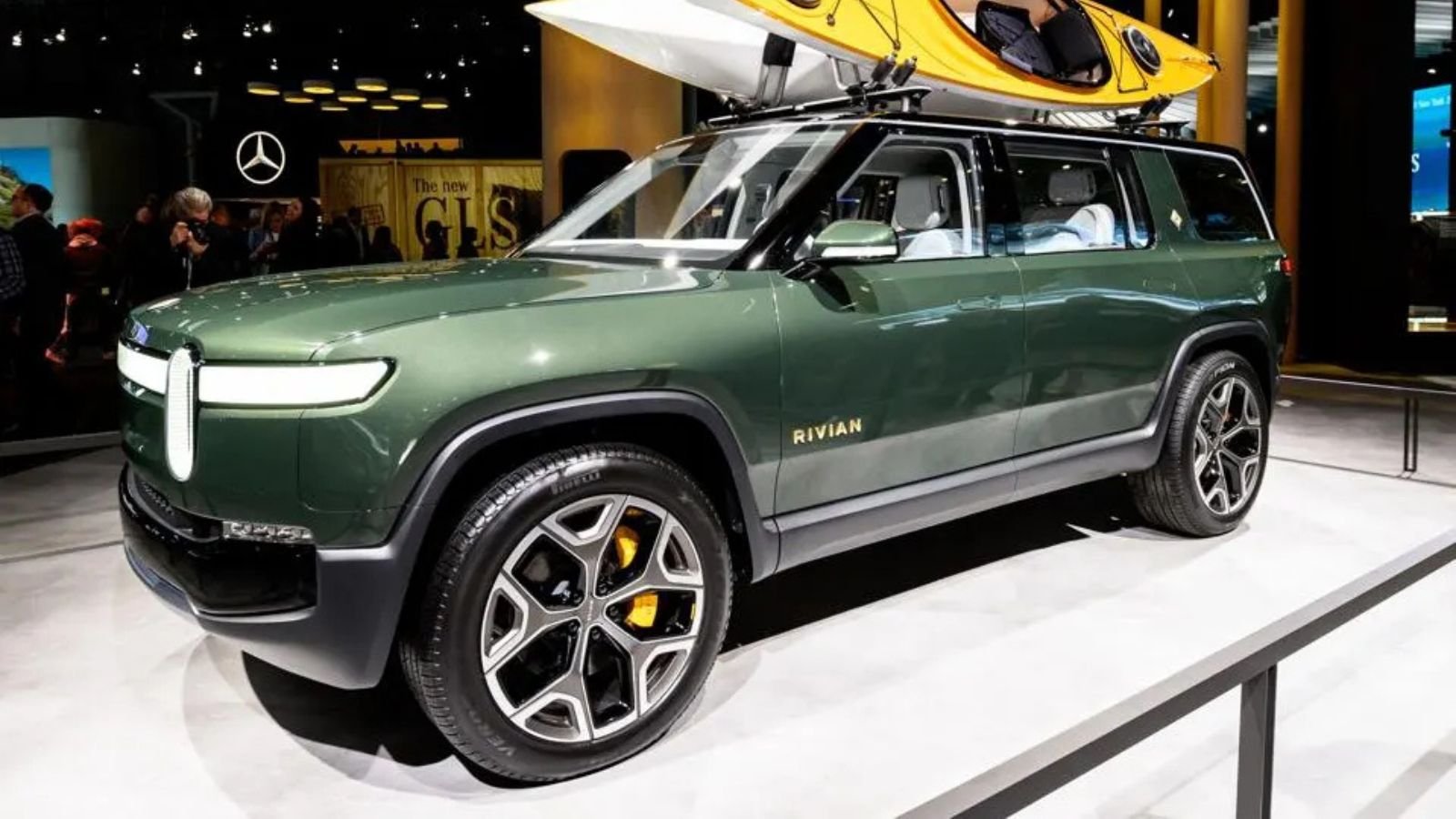The automotive industry is buzzing with excitement as Rivian prepares to bring its highly anticipated 2026 Rivian R2 into production. Since its initial debut, the R2 has been positioned as a more affordable and accessible EV in Rivian’s lineup, while still carrying forward the adventurous spirit and innovative features that have made the brand stand out. However, as with many concept-to-production transitions, some features evolve, some are dropped, and others get refined to ensure a balance between cost, practicality, and customer appeal. The 2026 Rivian R2 has already been spotted on U.S. roads, and early glimpses reveal a lot about what we can expect from this new electric SUV.
Design & Exterior Changes
One of the biggest talking points surrounding the 2026 Rivian R2 is the retention of its dropdown rear glass. This feature was shown during the R2’s debut and, much to the delight of fans, has made it into production. This rear glass adds versatility for outdoor enthusiasts, campers, and families who want quick access to the cargo area or want better ventilation when on long road trips. In fact, very few SUVs currently offer this—one of the rare examples being the Toyota 4Runner, which has held onto the feature in its sixth-generation redesign. Rivian keeping it in the R2 shows the brand’s commitment to functional and unique design elements that set it apart.
Beyond this, the R2’s production-ready form has introduced some necessary changes. For instance, the charge port location has been shifted from the right rear fender (as seen in the debut model) to the driver-side rear fender. The reason is purely functional—this aligns the R2’s charging location with Tesla’s setup, making charging at Superchargers far more seamless. With Rivian having plug-and-charge access to Tesla’s network, this adjustment is more than logical; it’s essential for convenience and compatibility. The production model now has a larger, more practical charge port door, ensuring easier operation for owners.
The R2 prototypes spotted in testing also reveal a rugged setup. Rolling on BFGoodrich Trail-Terrain A/T tires and boasting yellow brake calipers, the SUV has a muscular stance. The yellow calipers are worth noting—they usually indicate a tri-motor setup in Rivian’s higher-end models, hinting at serious performance potential for the 2026 Rivian R2.
Interior & Feature Adjustments
As with any transition from concept to production, compromises must be made. Rivian CEO RJ Scaringe has confirmed that some of the flashier features of the R2 concept won’t make it to the production line. For example, the much-discussed accessory port—a plug-and-play solution for mounting outdoor equipment and add-ons—has been scrapped. The reasoning? Cost, market demand, and practicality. Scaringe explained that even if a small percentage of buyers wanted the accessory port, the costs would be spread across all vehicles, raising the base price for everyone. Instead, the tow receiver will serve as the new mounting point for accessories. While not as sleek or effortless as the original port, this solution remains functional and keeps costs under control.
Another cutback is the fold-flat front seats. Initially shown to allow for in-car camping and greater flexibility, the feature won’t make it to production due to similar cost-vs-usage concerns. However, Rivian still intends to keep the R2 camper-friendly. The SUV will launch alongside a factory-backed rooftop tent accessory, ensuring adventure-seekers have options for overnight stays. Additionally, while the front seats won’t fold flat, the rear cargo space will still provide enough room for sleeping inside the vehicle, keeping the R2 true to Rivian’s adventurous DNA.
Performance & Powertrain Options
Performance is another area where the 2026 Rivian R2 is set to shine. Rivian has confirmed that the SUV will be available with a single-motor, dual-motor, and tri-motor powertrain lineup. The entry-level single-motor variant will make the R2 accessible to more buyers, especially with a target starting price around $45,000. This aligns Rivian with its goal of bringing electric adventure vehicles to a broader audience.
The dual-motor option will provide a balanced mix of performance and efficiency, while the tri-motor version is shaping up to be a real powerhouse. Early indications suggest that the tri-motor R2 could accelerate from 0–60 mph in under three seconds. If this proves true, the R2 would be one of the quickest vehicles in its class, rivaling performance EVs that cost significantly more. For a lower-cost SUV, this kind of speed is nothing short of remarkable.
The prototypes spotted testing with yellow brake calipers give further weight to the expectation that Rivian’s tri-motor system is indeed on the way. This would give drivers not only blistering acceleration but also excellent off-road capability, traction, and control in tough environments.
Practicality & Everyday Usability
While Rivian has had to scale back some of its more ambitious features, the 2026 Rivian R2 is shaping up to be one of the most practical EVs for families and adventure-seekers alike. The dropdown rear glass provides functionality for tailgating, camping, or hauling larger items. The updated charge port ensures compatibility with the largest fast-charging network in the U.S., a major selling point for EV adopters who worry about range anxiety.
The towing setup also promises to be versatile. By integrating accessory mounts with the tow receiver, Rivian ensures that owners can still carry bikes, storage racks, or outdoor gear without requiring overly complicated solutions. The shift from concept luxury to production pragmatism may feel like a step back to some, but for the broader market, it actually makes the R2 more appealing.
Market Position & Competition
Rivian is aiming the 2026 Rivian R2 squarely at buyers who want an electric SUV that blends performance, practicality, and adventure-readiness at a relatively accessible price point. At $45,000, the R2 undercuts larger, more expensive EVs while offering a more premium and adventurous vibe than entry-level electric crossovers.
The R2 will inevitably be compared to models like the Tesla Model Y, Ford Mustang Mach-E, and even Rivian’s own R1S. Where it differentiates itself is in its unique combination of design touches (like the dropdown glass), outdoor-focused accessories, and Rivian’s reputation for adventure-driven engineering. Additionally, Rivian’s access to Tesla’s Supercharger network is a huge advantage over other legacy automakers who are still playing catch-up in charging infrastructure.
Rivian’s Vision & Production Plans
The 2026 Rivian R2 is expected to enter series production in Normal, Illinois, next year, marking another milestone for the young automaker. Rivian has faced challenges, including production delays and scaling issues, but the R2 could be the model that solidifies its place in the EV market. By offering a more affordable option without abandoning the adventurous ethos that defines Rivian, the company hopes to appeal to a wider customer base.
CEO RJ Scaringe has made it clear that Rivian must carefully choose which features to bring into production and which to cut. His reasoning underscores the difficulties of being a startup automaker—where every added feature brings significant costs that must be passed down to customers. By focusing on high-value, widely used features, Rivian ensures that the 2026 Rivian R2 remains competitive in both pricing and appeal.
Final Thoughts
The 2026 Rivian R2 is shaping up to be one of the most exciting EV launches of the decade. While some enthusiasts may be disappointed by the removal of the accessory port and fold-flat front seats, the SUV still retains a wealth of thoughtful, practical, and unique features. The dropdown rear glass, rooftop camping accessories, tri-motor powertrain option, and compatibility with Tesla’s charging network all make the R2 stand out in an increasingly crowded electric SUV market.
It’s clear that Rivian is playing the long game with the 2026 Rivian R2. By trimming the fat and focusing on features that most customers will use and appreciate, Rivian is setting up the R2 to succeed where many EVs stumble: balancing cost with capability. If Rivian can deliver on its promises of performance, usability, and affordability, the R2 could very well become one of the most popular EVs in its class.
With production set to begin soon, it won’t be long before we see the 2026 Rivian R2 on the roads in large numbers. For now, spy shots and confirmed details give us a glimpse of an SUV that feels adventurous, practical, and distinctly Rivian—exactly what fans and future owners have been hoping for.
Some Important Link
| Download News APP | Click Here |
| WhatsApp Group | Click Here |
| Home Page | Click Here |





